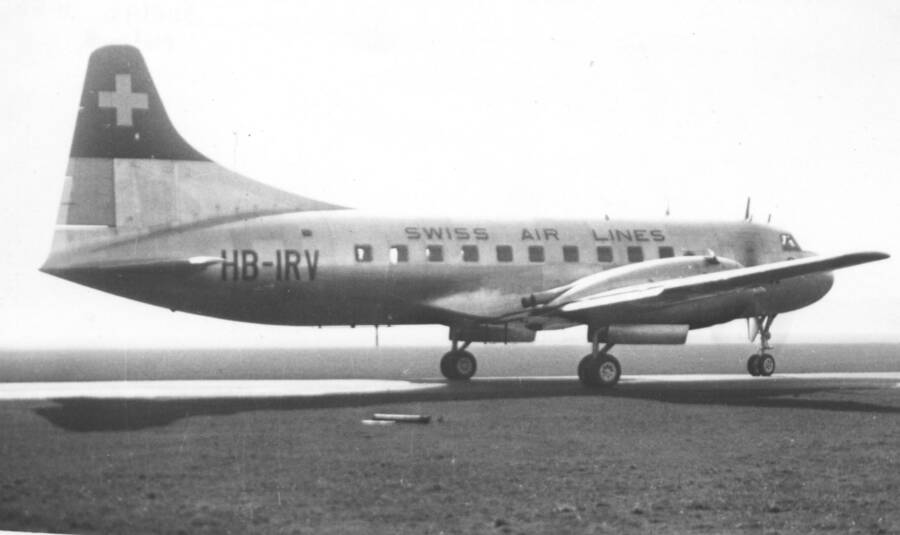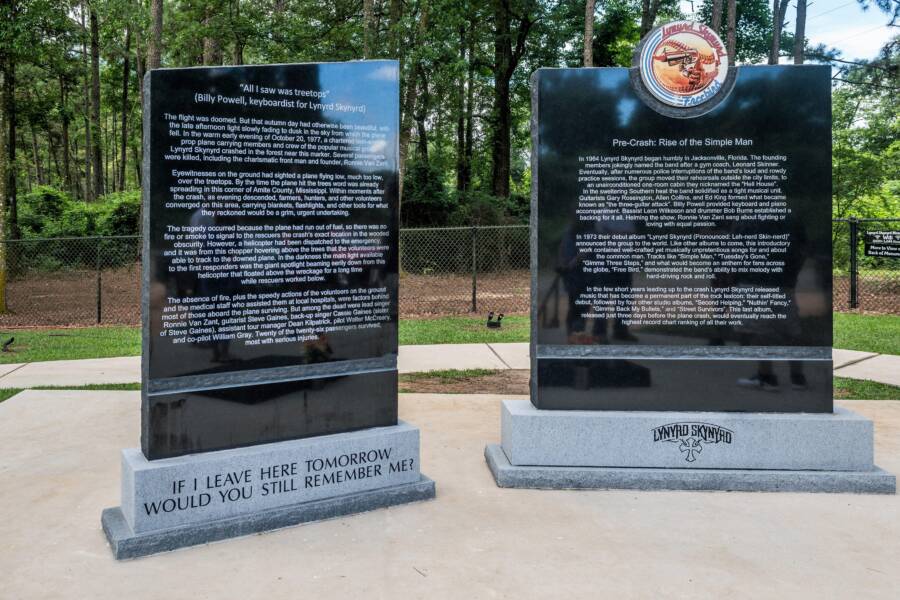The devastating Lynyrd Skynyrd plane crash near Gillsburg, Mississippi on October 20, 1977, claimed the lives of both pilots and about half of the band's members.

Pictorial Press Ltd / Alamy Stock PhotoLynyrd Skynyrd lost half of its band members in the 1977 plane crash.
Three days after releasing their fifth album, Street Survivors, Lynyrd Skynyrd boarded an airplane bound for Baton Rouge, Louisiana. There was one problem, however: The plane didn’t have enough fuel to make it there. The pilots attempted an emergency landing, but their efforts were in vain. The infamous Lynyrd Skynyrd plane crash claimed the lives of three band members, the pilot, the co-pilot, and the band’s assistant road manager.
The band members were lead vocalist Ronnie Van Zant, guitarist Steve Gaines, and his sister, backing vocalist Cassie Gaines. Twenty others on board survived the crash, though none made it out unscathed. And as for the band, with half of its members now dead, it seemed that Lynyrd Skynyrd had reached the end of their road.
A decade later, Johnny Van Zant, the brother of Ronnie Van Zant, would reform the band as a tribute act, eventually going on to put out new music under the Lynyrd Skynyrd name. And while Lynyrd Skynyrd continued to be a success after the crash, it was never truly the same — and Oct. 20, 1977 is still remembered as one of the most tragic days in rock music history.
Who Were Lynyrd Skynyrd?
Lynyrd Skynyrd, in its first incarnation, was formed in Jacksonville, Florida by vocalist Ronnie Van Zant, guitarist Gary Rossington, guitarist Allen Collins, bassist Larry Junstrom, and drummer Bob Burns. Originally known as “My Backyard,” the band made music together for five years before changing the name to “Lynyrd Skynyrd” in 1969.

Wikimedia CommonsLynyrd Skynyrd in 1973.
Between 1969 and 1977, the band would make a few lineup changes, including adding bassist Leon Wilkeson, keyboardist Billy Powell, and guitarist Ed King. In 1974, Burns was replaced by Artimus Pyle, and in 1975, King left as well. A year later, in 1976, Steve Gaines joined the band — though his tenure would be tragically short-lived.
While Lynyrd Skynyrd were popular in their heyday, they are best known for the songs “Sweet Home Alabama” and “Free Bird.” And although the band is still around today, its lineup is obviously quite different — and that’s largely because of the 1977 plane crash.
“We Didn’t Know Any Better” — The Moments Just Before The Lynyrd Skynyrd Plane Crash
Lynyrd Skynyrd released their fifth studio album Street Survivors on Oct. 17, 1977. The album’s original cover artwork depicted the band members standing in a street, surrounded by flames — an image which, in hindsight, is disturbingly ironic. It was later changed to just feature the band against a black backdrop.

Wikimedia CommonsThe original album artwork for Street Survivors.
That year, Lynyrd Skynyrd were touring to promote their new album. Two days after its release, they played a gig at the Greenville Memorial Auditorium in Greenville, South Carolina, with the next stop on the tour set to be Louisiana State University in Baton Rouge.
At the time, they were flying in an old, rickety Convair CV-240. The plane was nearly 30 years old, and the flames that had shot out from its right engine when they flew it to Greenville did little to inspire confidence among the band members. Understandably, several members were hesitant to travel in it.
“Our wives, everyone were afraid for us to get on this thing, but we didn’t know any better,” Billy Powell recalled in a 1997 interview with VH1’s Behind the Music, according to Rolling Stone.
Cassie Gaines, backup singer and sister of guitarist Steve Gaines, mentioned that she was apprehensive to board the plane. Allen Collins felt the same way. The only person, it seemed, who was comfortable boarding the plane was Ronnie Van Zant. But he was able to convince the rest to get on.
“Ronnie said, ‘Hey, if the Lord wants you to die on this plane, when it’s your time, it’s your time. Let’s go, man. We’ve got a gig to do,'” Gary Rossington recalled in a 1988 interview with the Orlando Sentinel.

Wikimedia CommonsA Convair 240 from 1949, a similar model to the one that Lynyrd Skynyrd used.
Collins got on the plane, but he didn’t feel good about it. The band did decide, however, that once that plane touched down in Baton Rouge, they’d look for a new one to get them around.
“We had talked about that an hour before we went down,” Pyle said. “We had decided to get a Learjet for the band, a beautiful bus for the crew. It was ridiculous for us to be on an old plane like that.”
Of course, that old Convair never touched down in Baton Rouge, and Van Zant’s remark about dying on the plane seemed more like a premonition than words of reassurance.
The Impact Was “Like A Thousand People With Baseball Bats” Beating On The Fuselage
Less than three hours into their flight, things started going wrong. They had just passed over the closest airport, but they were burning fuel fast — and once again, the right engine was spitting out fire.
“We knew after the fire shot out of the right engine that we had a problem,” Pyle recalled to Forbes in a 2021 interview. “But we thought surely our pilots would land at the closest airport, and get us off of the plane to refuel. But they didn’t. They made several fatal decisions. I’ve never hated them or anything, because they didn’t want to die, their families didn’t want them to die.”
It became clear to the crew that an emergency landing was needed. They told the 24 passengers to strap in and get ready, hoping ultimately that they would belly land in a muddy field. Ten minutes later, the plane was down well below the clouds and clipping trees.
“The impact was like a thousand people with baseball bats repeatedly beating on the side of the fuselage,” Pyle told Forbes. “The whole thing lasted about 12 seconds. That’s a long time to be crashing.”
At around 6:52 p.m., the plane finally struck ground a few miles outside Gillsburg, Mississippi. In Lynyrd Skynyrd’s plane crash, both pilots died — one decapitated, the other in pieces in a tree — along with Ronnie Van Zant, Cassie and Steve Gaines, and assistant road manager Dean Kilpatrick. All things considered, Pyle and Powell made it out all right — but Rossington, Collins, and Wilkeson weren’t quite as lucky, suffering more serious injuries.

Robert Landau / Alamy Stock PhotoA tribute billboard over the Licorice Pizza record store on Sunset Boulevard.
“I jumped off and there were people screaming,” Powell said. “I remember hearing Leon [Wilkeson] screaming, ‘Get me out of here.’ People that were still in the fuselage were trapped by seats and debris and metal and stuff. I just walked around trying to help whoever I could.”
Pyle, meanwhile, ran to try and find help along with two members of their road crew, Ken Peden and Mark Frank. With cracked ribs, Pyle made his way through a swamp and wound up in the front yard of a farmer named Johnny Mote. Mote aimed a gun at Pyle until the rocker fell to his knees and said, “Plane crash.”
“When we first got down there, you could hear them whining,” Mote later said. “Some of them were crying and hollering. It got to me.”
The Aftermath Of The Lynyrd Skynyrd Plane Crash
The crash prompted an investigation from the National Transportation Safety Board (NTSB), who ultimately found the crash was likely caused by “fuel exhaustion and total loss of power from both engines due to crew inattention to fuel supply.”
Although the plane had taken on 400 gallons of fuel before its departure in Greenville, the right engine — the one that was spitting fire — was burning through it at an alarming rate. That said, the NTSB report noted that the crew had been “either negligent or ignorant” of the rapid burning of fuel because they were not properly monitoring it early in the flight.

BHammond / Alamy Stock PhotoA monument at the site of the plane crash that commemorates the lives of the Lynyrd Skynyrd band members who died.
If they had been, they could have redirected their flight path to stop and refuel along the way. If there is any silver lining, however, it’s that there was too little fuel for the plane to erupt into flames when it crashed, which helped to save more lives.
The surviving band members tried, for a time, to form another group, but personal issues — and the enduring pain of losing their friends in the crash — stopped that dead in its tracks.
Lynyrd Skynyrd eventually reunited in 1987, with Johnny Van Zant as the new vocalist, for a reunion tour. They continued to put out music over the course of 40 more years, but the impact of that plane crash never faded.
“Ronnie knew his destiny,” Pyle said. “He told me in Tokyo, Japan, that he would never live to see 30, and that he would go out with his boots on. At the time, I just said, ‘Oh Ronnie, don’t talk like that. You’re going to live forever.'”
After reading about the 1977 Lynyrd Skynyrd plane crash, read about other tragic air disasters in music history, including those of Patsy Cline, John Denver, Otis Redding, and Aaliyah.





